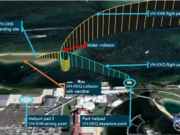The Beech King Air 65-A90 that crashed in June after takeoff from a Hawaiian airport was inverted in a 45-degree nose-down attitude just before it struck the ground, killing the pilot and all 10 passengers on the sunset skydiving flight, the U.S. National Transportation Safety Board (NTSB) says.
The NTSB released a preliminary report Tuesday on the accident, which occurred during departure from Dillingham Airfield in Mokuleia, Hawaii, U.S.
The accident flight was the fourth of five parachute jump flights scheduled on June 21 by the Oahu Parachute Center, the preliminary report said. Passengers included the pilot, three tandem parachute instructors and their three customers, two camera operators, and two solo jumpers.
A parachute center instructor told accident investigators that the King Air’s engines sounded normal during the initial ground roll, “consistent with the engines operating at high power.” As the airplane came into view, the instructor said it was between 150 and 200 ft above the ground and appeared to be turning.
The report added, “The final second of the accident sequence was captured in the top left frame of a surveillance video camera located at the southeast corner of the airport. Preliminary review of the video data revealed that just before impact, the airplane was in an inverted 45-degree nose-down attitude.”
The airplane burst into flames on impact, just inside the airport perimeter fence, the report said.
The NTSB’s investigation of the crash is continuing.
The accident was characterized as the deadliest in the United States since the Sept. 16, 2011, crash of a North American P-51D Mustang at the Reno (Nevada) Air Races, which killed the pilot and 10 spectators and seriously injured 66 people on the ground.
.



